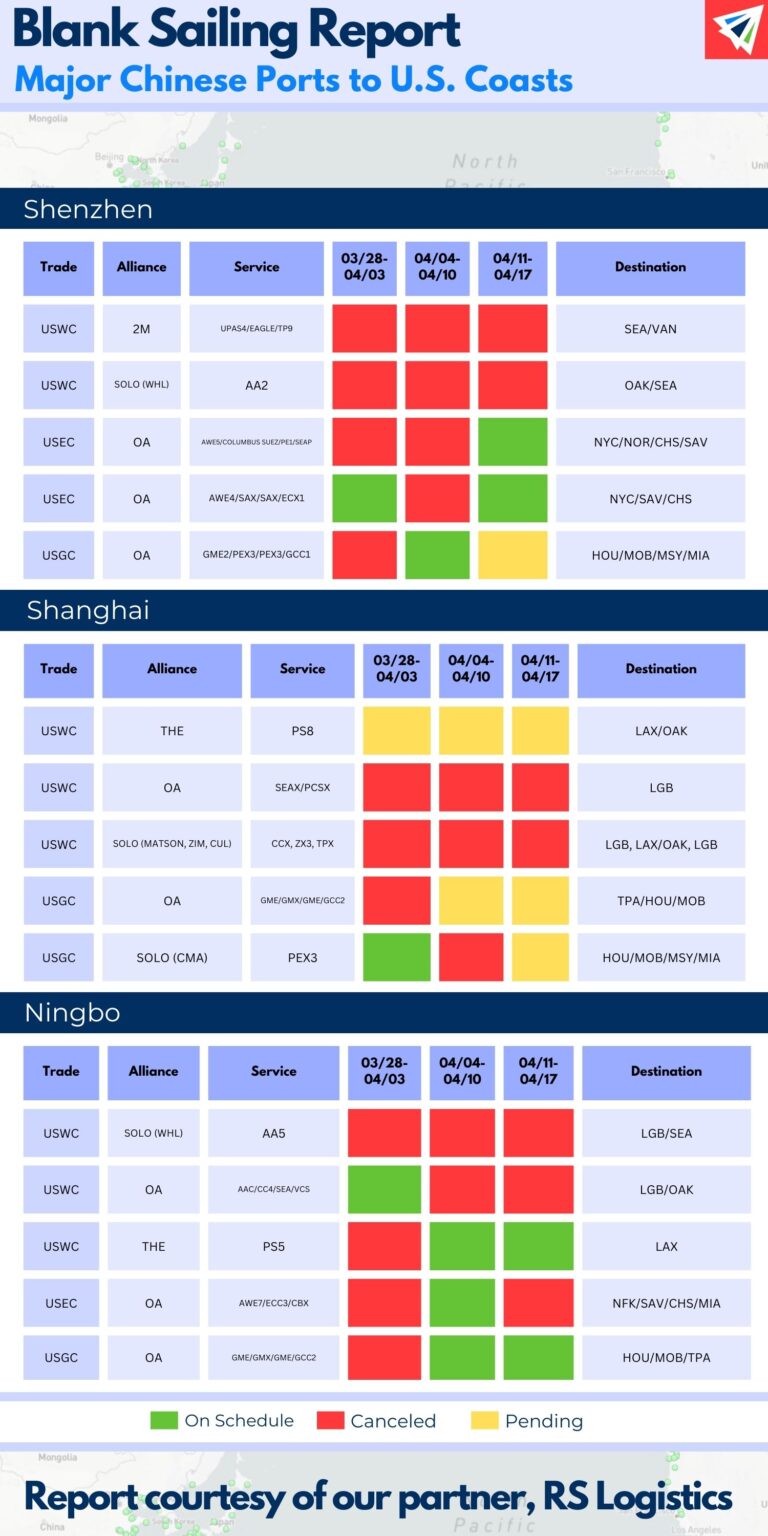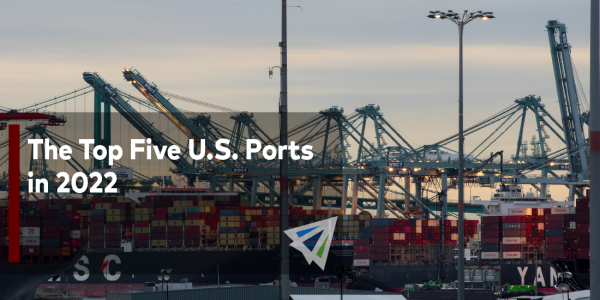Competitive Edge
March 22nd, 2023

Note the above services are where the greatest number of blank sailings are occurring on the transpacific eastbound lane. Other services as well may have announced cancellations or delays. Please contact us if there is a specific service or trade you are concerned about.
We extend our thanks to our Chinese partner RS Logistics for providing these reports.
IMPORT: Asia to North America (TPEB)
Recent Developments:
• West Coast contract negotiations (between the International Longshore and Warehouse Union (ILWU) and Pacific Maritime Association (PMA)) remain active. The existing labor contract between the two parties expired July 1, 2022. “Significant delays” have hit a few terminals at Los Angeles and Long Beach due to recent job actions by dockworkers linked to ongoing West Coast contract talks.
• Carrier aggression is showing its teeth again as instances of general rate increase (GRIs) become more common heading into April. Blank sailings are still in play as well.
Rates: Rates to all US coasts remain low and level.
Space: Space is open.
Capacity: Capacity is open. However, expect a continued presence of blank sailings.
Equipment: Unless advised otherwise, availability is open at inland and coastal ports.
TIPS:
• Book at least two weeks prior to the ready date.
• Blank sailings will be routine through Q1 2023.
IMPORT: Europe to North America (TAWB)
Recent Developments:
• Relatively high rates and their profitability continue to attract carriers’ attention to the transatlantic market. However, expect the trade to eventually soften as demand dips below last year standards.
Rates: With capacity increasing and demand dropping, rates remain in a downward descent. However, they are still notably high when compared to pre-pandemic levels.
Space: Space is open to all U.S. coasts as congestion becomes an odd factor.
Capacity: Capacity continues to loosen as the market sees more ships, including larger ones, entering the market. It is set to increase even more with congestion having subsided.
Equipment: Availability has improved on both sides of the trade.
TIPS:
• Book at least three weeks prior to ready date.
• Even as market conditions become more fair, premium services (i.e., no-roll options and improved cargo reliability) should still be considered.
• Blank sailings have not been routine for this market but remain in close contact with providers to be aware of any developments.
EXPORT: North America to Asia
Rates: Rates continue to slip downward at a slight clip.
Space: Space is wide open.
Capacity: Capacity is widely available for all services. No considerable changes to this market’s capacity through Q2 2023.
Equipment: It can be generally said that most inland points and seaports have balanced equipment availability. If any uncertainty exists, it would be chassis availability at select inland hubs.
TIPS:
• Book at least two weeks prior to the time of departure.
• Blank sailings have not been routine for the market but remain in close contact with providers to be aware of any developments.
• Shippers with high volume projects should take advantage of carrier receptiveness to take on these opportunities. Space is wide open with a high acceptance rate.
InterlogUSA Proudly Presents...Freight FM
Check out our latest episode of FreightFM…Staying Ahead of the Market Curve!
We discuss current market conditions and share different tips for shippers on how best to prepare when the market fluctuates.
Did You Know: Diesel Prices are Down Seven Straight Weeks
For the seventh week in a row, diesel prices dropped which had made the weekly average retail price down another 6.2 cents per gallon.
This has put the benchmark priced for the majority of fuel surcharges at $4.185 per gallon.
Freight News
Optimism Looms for a Restocking Surge in Europe
Even with high inflation, warehouses throughout Europe remain full.
However, there’s some thought that inventories will be depleted by the end of the second half of this year, which some hope will drive a rebuilding of inventory.
“Once the retailers start to empty their warehouses, which is likely to happen at the end of the second quarter and beginning of the third quarter, volume should increase and stop the fall in rates,” Viki Keckarovska, a freight team leader at UK-based analyst Ti, detailed in a webinar last week.
Many experts are anticipating the overall demand situation to improve in the second half of 2023.
Container Volumes Fall at the Majority of U.S. Ports
Out on the West Coast:
- The Port of Los Angeles saw a 43 percent year-over-year decline in container cargo.
- While its neighboring port, the Port of Long Beach saw a 32 percent year-over-year decline.
- Plus, the Port of Seattle/Tacoma saw a 24 percent year-over-year decline.
For the first two months of this year at the Port of LA, 1,213,860 TEUs have been handled compared to 1,723,360 back in 2022 – which is about a 32 percent decline.
Out on the East Coast:
- The Port of Savannah saw a 14 percent year-over-year decline.
- While the Port of Charleston saw a 12.6 percent year-over-year decline.
Declines in February were largely due to overstocked warehouses, an overall slowdown in global trade, and a shift from the USWC ports.
Watch Last Week's Webinar!
Topics:
- Strategies for succeeding in the freight market
- Upcoming RFQ Season: Evaluating all areas of business
- 2M split and how that will impact ocean shipping
- Market Updates
Sign Up for April's Webinar
Our next webinar will be on Wednesday, April 19th!
We will announce topics in the coming weeks. If you have any questions or topics you would like our experts to discuss in future webinars, please let us know!
Interlog  Insights
Insights
In last week’s newsletter, we discussed what lies ahead regarding the labor talks out on the USWC.
We also provided insights on some of the first signs of 2M’s “pre-split” process.
Don’t forget to sign up so you don’t miss week four of our March Interlog Insights!
Sign up for our
industry answers
Our team works to provide valuable, unique, and relevant content to assist you in finding solutions. Sign up now.

